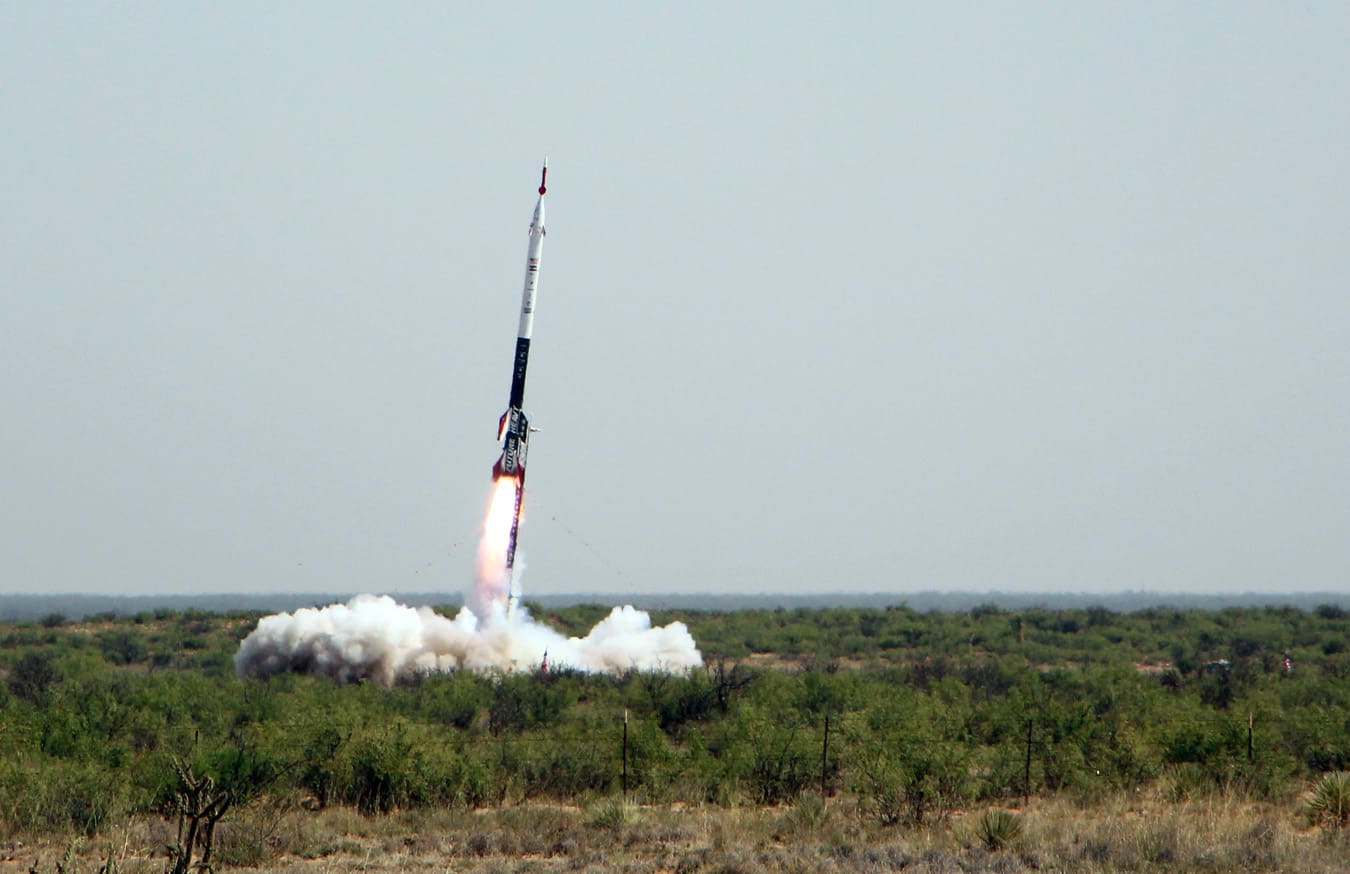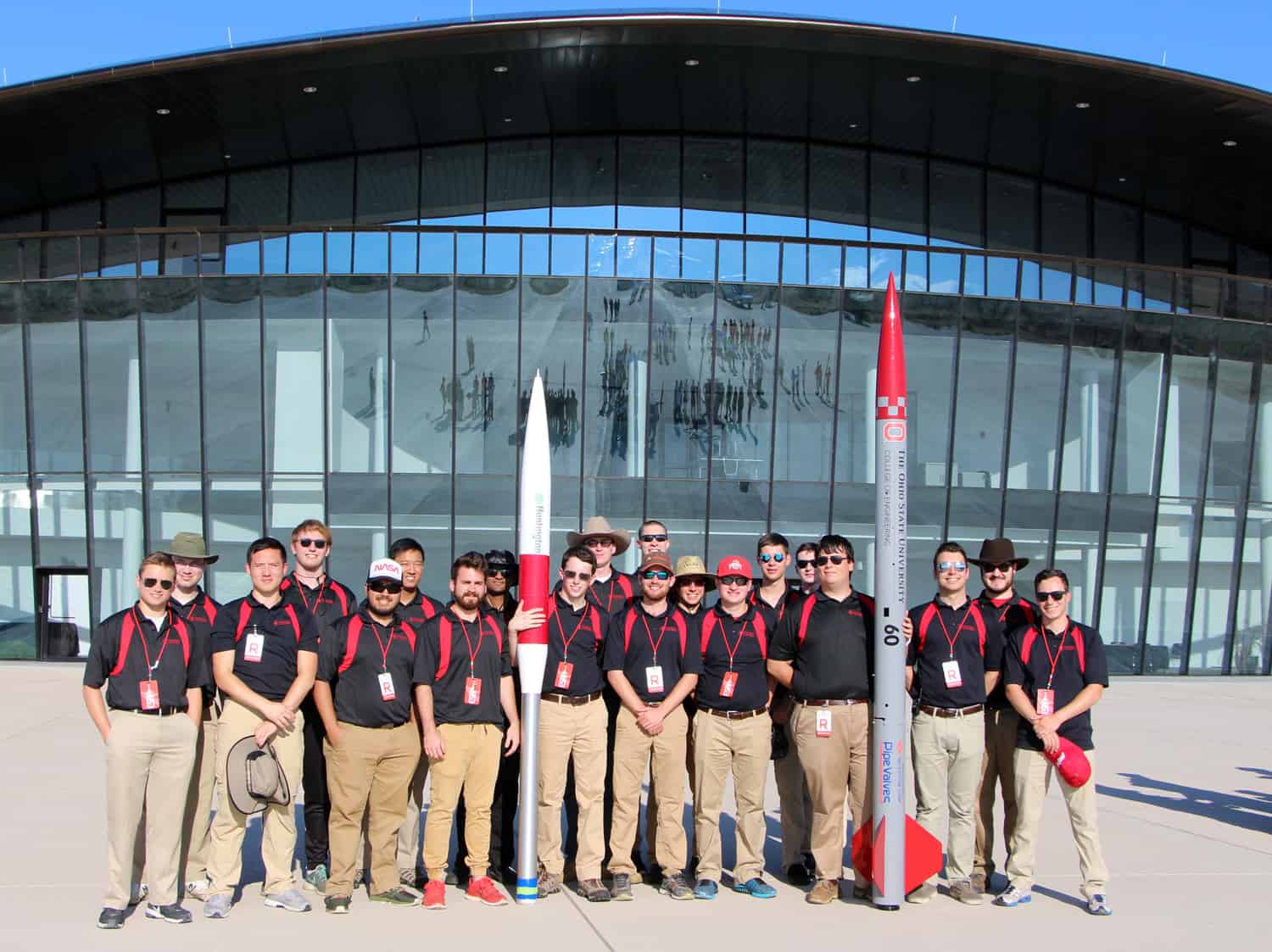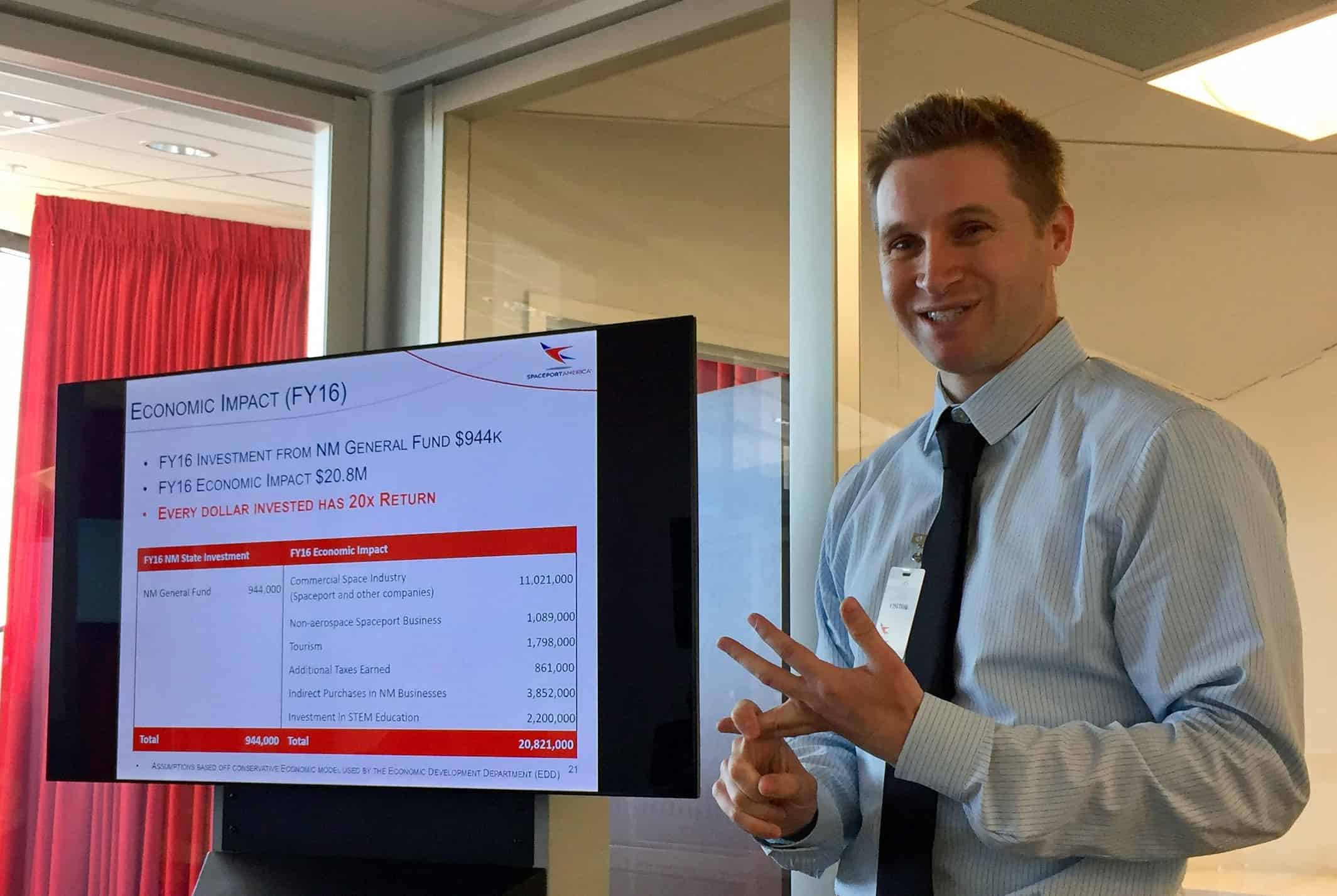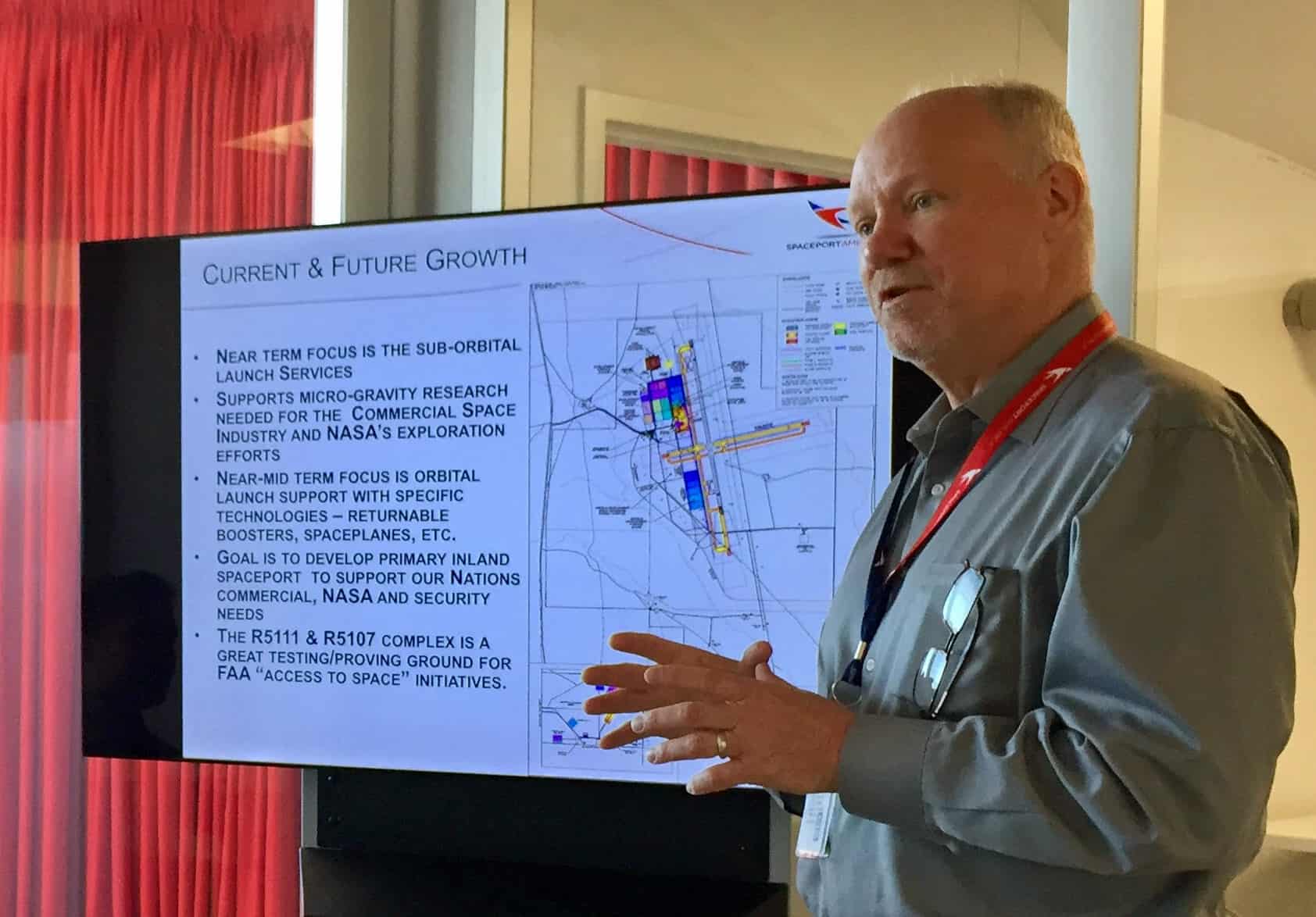An NMPolitics.net investigation finds challenges, but also reason for optimism
The Spaceport America Cup – a rocket-launching competition that brought more than 1,100 college students to southern New Mexico in June – was “easily the largest city-wide event in the last 10 years” in Las Cruces, a hotel company says.
The event helped Hotel Encanto and Hilton Garden Inn keep workers employed in a historically slow tourism month, the company says.
The students launched their rockets from Spaceport America, located east of Truth or Consequences, and there was some increased tourism in that city too. Ticket sales were up at El Cortez movie theater during the rocket competition, according to Moshe Koenick, who runs the theater in T or C. So was business at Koenick’s store, Dust & Glitter.
And though two fatal accidents have delayed Virgin Galactic’s planned flights of paying customers into space from southern New Mexico for years, the company currently has 21 employees in Las Cruces. Virgin Galactic says it’s moving another 85-90 here from Mojave, California when testing of its space vehicle is complete, which could happen in the coming months.
New Mexico’s investment in Spaceport America is a long way from spurring creation of the 5,000 new jobs then-Gov. Bill Richardson promised state lawmakers and voters in Doña Ana and Sierra counties a decade ago when they agreed to provide about $220 million to fund the project.
At the time, officials envisioned a new commercial space economy that would transform southern New Mexico and help the state become less dependent on the oil and gas industry. Virgin Galactic, founded by British billionaire Sir Richard Branson, would make its home here. The state would attract other space companies. Funding for space-related K-12 education programs would create a pipeline to help New Mexico’s kids snag the new jobs and be able to stay in New Mexico, if they chose.
The state took a risk back then, constructing the first facility anywhere that was designed and built for commercial spaceflight. But Virgin Galactic’s struggles to complete SpaceShipTwo have delayed the level of activity officials anticipated. The commercial space industry is highly competitive, and Florida and Virginia are among the states now building successful partnerships with other space companies. Skepticism among some public officials in New Mexico has also slowed Spaceport America’s progress.
Though today’s reality is far short of the vision laid out years ago, a months-long NMPolitics.net investigation found reason for optimism. The spaceport is spurring tourism and has created some jobs in southern New Mexico. Experts suspect the spaceport’s impact on the economy may already be greater than it estimates. Many officials are optimistic about the spaceport’s new CEO, Dan Hicks, who took the reins in September after a 34-year career at White Sands Missile Range.
And if Virgin Galactic begins flights in 2018, as Branson recently suggested, southern New Mexico’s commercial space economy could take flight.
The spaceport’s team “has the right skill set, vision and motivation” to lead in today’s commercial space industry, said Lt. Gov. John Sanchez, a non-voting member of the spaceport’s governing board and chair of the national Aerospace States Association.
Spaceport America, the Republican predicted, “will become a key port for our nation’s access to space” and a “transportation hub” for cargo and passengers traveling to points around the planet.
But Spaceport America has some challenges to overcome. For starters, New Mexico needs a professional study to give officials and the public a better sense of the economic activity it’s generating.
An incomplete study
Virgin Galactic’s hangar at Spaceport America rises toward the sky in the remote desert, a 12,000-foot runway at its side and a separate office building nearby. A tall fence surrounds the state-owned spaceport to prevent deer and oryx from wandering onto the runway and keep out unauthorized people. Armed security guards keep watch. A firefighting crew is on hand.
Since last fall, Spaceport America officials have been showing a slideshow that makes a claim as grand as the futuristic structure they built: that the state saw a 20-fold return on its investment in the spaceport in terms of economic impact in Fiscal Year 2016.
The state contributed $944,000 to the spaceport’s budget that year. The slideshow claimed the spaceport generated $20.8 million in economic activity. That proves, spaceport officials say, that the facility is fully functional and having a significant impact.
But that analysis isn’t a reliable measure of the spaceport’s activity, some economists interviewed for this article said.
The primary issue is that the analysis counts public money invested in the project as economic impact alongside private spending. That includes $2.2 million that Doña Ana and Sierra counties spent on science, technology, engineering and math (STEM) education programs that year from a tax increase that also helped fund spaceport construction. It appears to also include other public spending on the spaceport.
“The spaceport economic impact study suffers from a classic mistake, which is to only count the benefits and not count the costs,” said Chris Erickson, an economics professor at New Mexico State University. “For that reason, it can’t be taken seriously.”
That doesn’t mean all is lost, or that spaceport officials are lying. Analyzing economic impact is complicated. In some cases, public money could be counted as a benefit, economists said. It’s all about who your audience is – and in this case, spaceport officials who counted the local tax money as economic impact were presenting to legislators who provide separate, state funding for the spaceport.
Regardless, the slideshow doesn’t provide a clear picture to help the public consider whether its investment in the spaceport – through state funding and local tax increase – has attracted sufficient private investments.
The slideshow is labeled an “economic impact” study. But Jim Peach, also an NMSU economics professor, said the spaceport’s study lacks information such a study should include. “There’s enough that they’re not saying here that it’s hard to evaluate the claims,” Peach said.
The analysis was done in-house by Zach De Gregorio, the spaceport’s chief financial officer, who has master’s degrees in accounting and finance. He said the slideshow is based on “anecdotal discussions” with government officials and business owners that gave him “a sense of the activity at Spaceport America.”
NMPolitics.net requested all documents that went into De Gregorio’s analysis to try to investigate his claims. We wanted to review financial records, including payments from Virgin Galactic and other companies doing business there, that appeared to be included in De Gregorio’s analysis.
“There are no more documents,” De Gregorio told NMPolitics.net. And Hicks said De Gregorio’s notes were destroyed.
Instead of providing the documents NMPolitics.net requested, Hicks invited NMPolitics.net to a forum at Spaceport America in April with spaceport and Virgin Galactic staff and three area economists, including Peach. The economists told spaceport officials that De Gregorio’s analysis was not an economic impact study. They asked questions to better understand the spaceport’s impact.
And they came away impressed by what they heard.
The spaceport wasn’t measuring areas of impact it should be, the economists discovered. For example, Kevin Boberg, NMSU’s vice president for economic development, said at the forum he didn’t want to know only how many hotel rooms were booked for the Spaceport America Cup in June. He wanted to know how many nights people stayed and how much they spent each day.
And while De Gregorio’s analysis included the investment of tax money in STEM education, Boberg said the spaceport needs to measure how that money aids retention of grade-school students. “I want to know outcome,” Boberg said.
Given what was missing from De Gregorio’s analysis, Peach said the impact might be greater than the spaceport claims.
“I can conceive of this being an underestimate,” Peach said during that forum.
Also impressed was economic analyst Erin Ward, who conducted a study for the U.S. Department of Defense on the impact of regional military installations in 2013. Her study included a quick analysis of the spaceport’s impact, which she estimated that year at $19 million, from a combination of public and private spending.
“I’m optimistic about the future,” Ward said after the forum at Spaceport America.
Hicks said he believes De Gregorio’s analysis was conservative and he was heartened by the reactions of the economists.
“We’re here to create an economy,” Hicks said. “That’s what our mandate was and that’s what I think we’re here being very successful at doing.”
Some of the economists said Spaceport America needs a professional economic impact study, the type that the NMSU economists can do. And the spaceport needs to be careful and accurate in its communications with the Legislature, which holds its purse strings, Peach and Erickson said.
Spaceport officials should “not try to do the things they don’t have the expertise to do,” Erickson said.
“Economists don’t build spaceships, and spaceports shouldn’t do economic impact analyses,” he said.
Hicks told NMPolitics.net he’s aware of the need for a professional economic impact study but the agency can’t afford it. Such studies can cost tens of thousands of dollars. Hicks said he is instead hoping to partner with master’s-level economics students at NMSU this fall to conduct a new analysis.
Peach is sympathetic to the spaceport’s budget situation. “Mr. Hicks is an honest and honorable man. There was no attempt to exaggerate anything. With limited resources, they did the best they could,” he said.
Boberg said he believes De Gregorio “reasonably responded” to the Legislature’s request for information with his analysis. And he said Spaceport America appears “to be on course to begin realizing some of the aspirations folks had so many years ago.”
Still, without a full economic impact study, it’s difficult to know with certainty.
Economic activity
So what do we know about the economic activity Spaceport America is generating?
Fifty-one people currently have government jobs with the Spaceport Authority – including Hicks and his staff in Las Cruces and the contract fire and security crews at the spaceport, Hicks said. Most are full-time positions. Those people spend money in the local economy.
UP Aerospace continues launching research and other payloads from Spaceport America, which it has been doing since 2006. Hicks said the company has launches scheduled for later this year.
ARCA Space Corporation is developing a lower-cost rocket in Las Cruces that would carry heavy payloads into space. It’s also taking orders for a hoverboard at a cost of $14,500. In February, the company said it had made $350,000 from hoverboard orders.
In addition to Virgin Galactic and UP Aerospace, three other companies have leases at Spaceport America – SpaceX, EXOS Aerospace and EnergeticX. Spaceport officials don’t say much about what those or other clients are doing. They redacted rent and fee information from most lease agreements provided to NMPolitics.net, which may violate state transparency law, but they released Virgin Galactic’s without redactions. De Gregorio’s analysis states that space companies other than Virgin Galactic spent $1.3 million in New Mexico in Fiscal Year 2016.
His analysis also states that film and commercial shoots at the spaceport netted $1.1 million in direct spending.
Then there’s the biggie, Virgin Galactic. The company’s direct spending was $3.3 million in Fiscal Year 2016, according to De Gregorio’s analysis. That’s expected to jump in 2018, when Virgin Galactic’s rent increases from $1 million per year to about $3 million.
Virgin Galactic had paid $7.1 million in rent and user fees to the state for its use of a hangar and other facilities at Spaceport America as of April 2017, according to Jonathan Firth, the company’s executive vice president for spaceport and program development. Since 2010, Firth said, the company has spent another $9.4 million with New Mexico businesses on construction and other things.
The company’s current employees in Las Cruces include Pete Nickolenko, who left a NASA career in Florida after 24 years to become Virgin Galactic’s director of spaceline engineering. As an example of how Virgin Galactic’s employees are putting money into the area economy, Nickolenko bought a home in Las Cruces and his two children are attending New Mexico colleges.
Tourism
Spaceport America has also had a tangible impact on tourism. A tour bus operator that contracted with the spaceport in Fiscal Year 2016 spent $1 million, De Gregorio’s analysis states. When he estimated related spending, including meals and hotels, De Gregorio placed the tourism impact that year at just under $1.8 million.
This year there’s likely more activity. Spaceport America hosted the college rocket competition for the first time this June and plans to continue doing so annually. More than 1,100 students traveled to southern New Mexico, some with family members and others, for the weekend. The convention center in Las Cruces filled up. The students launched rockets from Spaceport America.
As a result, Heritage Hotels, which operates Hotel Encanto and Hilton Garden Inn in Las Cruces, saw a 25 percent increase in total revenue in June 2017 compared to June 2016, according to a document the company provided spaceport officials. In one of the hotel industry’s slowest months, that included $100,000 in hotel-reservation revenue and $7,500 collected in taxes, the company says.
“Many businesses benefited during our traditionally slower summer months,” said Belia Alvarez, Heritage Hotels’ regional manager. “At our hotels, we were able to keep our team members fully employed as we saw a dramatic increase in room night sales for June.”
Other spaceport-related events have boosted regional tourism too, Alvarez said. And since 2010, Virgin Galactic staff and future astronauts have stayed at her company’s hotels when they’re in town for business or to tour the area. The partnership with Virgin Galactic has generated more than $250,000 in revenue for the company and resulted in nearly $21,000 in taxes collected, the document states.
As part of that partnership, Hotel Encanto has in recent years invested in upgrades to its VIP suites, pool area and other outdoor spaces. The hotel is “fully committed to providing a 5-star deluxe VIP service to the astronauts and others who travel to our area as part of the spaceport experience,” Heritage Hotels founder and CEO Jim Long said in a 2014 news release.
Other business owners said they’re also seeing an impact, though to differing degrees. Visitors, vendors and employees associated with the spaceport have stopped at Milagro Coffee Y Espresso in Las Cruces, owner Bernie Digman said. He has also taken the shop’s van to the spaceport to serve food and drinks at events.
Truth or Consequences Brewing Co., which opened in June, saw “some spaceport traffic” during the Spaceport America Cup, “but nothing major,” owner Marianne Blaue said.
“We did hear from a few guests that it was hard to get a hotel room this weekend in T or C because everything was all booked,” Blaue said, “so if I had to guess I’d say the hotels in T or C saw a significant impact from the spaceport event.”
And there’s Koenick, the owner of Dust & Glitter in T or C, who also runs the movie theater there.
“During the Spaceport America Cup, I had customers who were spectators, parents of launchers, and some of the launchers themselves,” Koenick said. “All of them spent money in my shop.”
The business brought by the spaceport isn’t as much as Koenick sees during a holiday weekend when people visit Elephant Butte, but he said the spaceport has had an impact.
“It’s not as much as some people in the area expected or were sold on, but it’s more than if there wasn’t a spaceport,” Koenick said.
If Virgin Galactic begins flying people into space, tourism could boom. The company says it has sold more than 600 tickets – some at a cost of $200,000, some at $250,000. Those future astronauts and people they travel with will spend several days in southern New Mexico.
What now?
So what’s needed for the spaceport to take flight? Some say it starts with Hicks. Many state officials joined the economists in telling NMPolitics.net they’re impressed with the new CEO and optimistic he can lead the spaceport to success.
Sen. George Muñoz, perhaps the Legislature’s biggest spaceport skeptic, has sponsored legislation to sell the spaceport in the past, unsuccessfully. After meeting with Hicks, the Gallup Democrat is taking a wait-and-see approach.
“I want to give this guy a chance to turn it around,” Muñoz said.
Virgin Galactic’s Firth spoke highly about Hicks’ vision to grow the spaceport.
“I think you have now an executive director at Spaceport America who’s got a vision of what’s possible with the resources that he’s got,” Firth said. “We will do whatever we can to support Dan Hicks and the team.”
Funding issues, including tension over whether the state or local communities should shoulder more of the burden, need to be resolved. New Mexico’s spaceport gets less public funding than facilities in Florida and Virginia. To attract new companies, Hicks’ team has identified additional infrastructure needs, including hangars and runways.
A professional economic impact study would provide a realistic assessment of the spaceport’s status and help lawmakers, local communities and spaceport officials plan for the future. If the results are as positive as some economists and spaceport officials suspect, the state might be willing to provide additional funding going forward.
The spaceport must also improve interaction with the public. NMPolitics.net documented multiple violations, and additional possible violations, of the state’s transparency laws in the course of our reporting. Those impact public perception and trust in the project.
And the biggie: Virgin Galactic has to get SpaceShipTwo into space with paying customers. That was the promise that sold New Mexicans on building a spaceport. It remains the thing that would reassure the public, said state Rep. Bill McCamley, D-Las Cruces.
“I think when Virgin starts launching a lot of these problems solve themselves, because you’re going to see more employees here and you’re going to see more people visiting, so it becomes a visible reality,” McCamley said.
Erickson said the spaceport “has the potential for being an economic driver for the community.”
“It’s a reasonably high-risk activity for a government to fund, but sometimes governments have to invest in the infrastructure to get the industry going,” he said.
McCamley pointed to the long-term plan he and other officials developed a decade ago for Spaceport America: By funding both economic development and education, they hoped to build a new economy and equip New Mexicans to land the good-paying jobs that would come with it.
“When we start moving in that direction, that’s when this will start being a real success,” McCamley said. “But it’s getting there, and I think that’s what’s important.”
Alvarez, the hotel manager, agreed.
“I fully expect Spaceport America to build on its early successes and become a strong regional economic driver,” she said.













